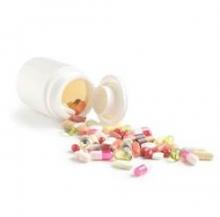User login
Females with major depressive episodes are more likely than are males to report past-year comorbid nonmedical use of prescription opioids, according to research published in Drug and Alcohol Dependence.
In addition, past-year drug abuse is strongly associated with both nonmedical use of prescription opioids (NMUPO) and major depressive episodes (MDE) in both females and males, reported epidemiologist David S. Fink and his associates.
Almost twice the proportion of women, compared with men, reported both MDE-alone and comorbid NMUPO and MDE. However, a higher proportion of males, compared with females, reported NMUPO-alone. In addition, NMUPO and MDE were significantly more common among people who were unemployed and those who reported lower annual family income, noted Mr. Fink, a PhD candidate at Columbia University, New York.
Among adolescent and adult respondents, 5.8% and 4.5%, respectively, reported any past-year NMUPO, while 8.6% of adolescents and 6.8% of adults met criteria for past-year MDE. The overall prevalence of comorbid NMUPO and MDE was 1.2% and 0.7% among adolescent and adult respondents, respectively. Data for the analysis came from the 2011 (n = 58,397) and 2012 (n = 55,268) National Survey on Drug Use and Health public use files. Cases of MDE were defined using DSM-IV criteria, and NMUPO history was based on self-reported data (Drug Alcohol Depend. 2015 Aug 1;153:258-64).
“This finding highlights a need for interventions to target both high-risk polydrug users and population level interventions to ameliorate misuse of prescription opioids,” the investigators concluded.
Read the full article here.
Females with major depressive episodes are more likely than are males to report past-year comorbid nonmedical use of prescription opioids, according to research published in Drug and Alcohol Dependence.
In addition, past-year drug abuse is strongly associated with both nonmedical use of prescription opioids (NMUPO) and major depressive episodes (MDE) in both females and males, reported epidemiologist David S. Fink and his associates.
Almost twice the proportion of women, compared with men, reported both MDE-alone and comorbid NMUPO and MDE. However, a higher proportion of males, compared with females, reported NMUPO-alone. In addition, NMUPO and MDE were significantly more common among people who were unemployed and those who reported lower annual family income, noted Mr. Fink, a PhD candidate at Columbia University, New York.
Among adolescent and adult respondents, 5.8% and 4.5%, respectively, reported any past-year NMUPO, while 8.6% of adolescents and 6.8% of adults met criteria for past-year MDE. The overall prevalence of comorbid NMUPO and MDE was 1.2% and 0.7% among adolescent and adult respondents, respectively. Data for the analysis came from the 2011 (n = 58,397) and 2012 (n = 55,268) National Survey on Drug Use and Health public use files. Cases of MDE were defined using DSM-IV criteria, and NMUPO history was based on self-reported data (Drug Alcohol Depend. 2015 Aug 1;153:258-64).
“This finding highlights a need for interventions to target both high-risk polydrug users and population level interventions to ameliorate misuse of prescription opioids,” the investigators concluded.
Read the full article here.
Females with major depressive episodes are more likely than are males to report past-year comorbid nonmedical use of prescription opioids, according to research published in Drug and Alcohol Dependence.
In addition, past-year drug abuse is strongly associated with both nonmedical use of prescription opioids (NMUPO) and major depressive episodes (MDE) in both females and males, reported epidemiologist David S. Fink and his associates.
Almost twice the proportion of women, compared with men, reported both MDE-alone and comorbid NMUPO and MDE. However, a higher proportion of males, compared with females, reported NMUPO-alone. In addition, NMUPO and MDE were significantly more common among people who were unemployed and those who reported lower annual family income, noted Mr. Fink, a PhD candidate at Columbia University, New York.
Among adolescent and adult respondents, 5.8% and 4.5%, respectively, reported any past-year NMUPO, while 8.6% of adolescents and 6.8% of adults met criteria for past-year MDE. The overall prevalence of comorbid NMUPO and MDE was 1.2% and 0.7% among adolescent and adult respondents, respectively. Data for the analysis came from the 2011 (n = 58,397) and 2012 (n = 55,268) National Survey on Drug Use and Health public use files. Cases of MDE were defined using DSM-IV criteria, and NMUPO history was based on self-reported data (Drug Alcohol Depend. 2015 Aug 1;153:258-64).
“This finding highlights a need for interventions to target both high-risk polydrug users and population level interventions to ameliorate misuse of prescription opioids,” the investigators concluded.
Read the full article here.
FROM DRUG AND ALCOHOL DEPENDENCE

